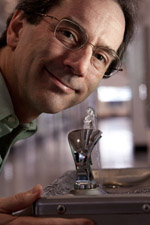Recommended

Update: View a video of the presentation.
More than a billion people worldwide lack access to clean drinking water. Sea water is one possible solution. But current methods of desalination are expensive, energy intensive, and require infrastructure not usually available in areas most in need of it.
Tune in to hear how MIT Mechanical Engineering Professor John Lienhard P'15, who is also the director of the Center for Clean Water and Clean Energy at MIT and King Fahd University of Petroleum and Minerals, applies basic science and engineering to address this problem.
Lienhard will offer his thoughts and take questions from the worldwide MIT alumni community via video chat on Thursday, Feb. 2, from Noon to 12:30 p.m. ET.
Register for this free event to receive the link for live viewing. After the event, come back here and continue the conversation in the comments.

About John Lienhard
John Lienhard P'15 is a professor of mechanical engineering at MIT as well as the director of the Center for Clean Water and Clean Energy at MIT and King Fahd University of Petroleum and Minerals.He earned his BS and MS in chemical, nuclear, and thermal engineering at the University of California, Los Angeles and a PhD in fluid dynamics from the University of California, San Diego.
His research interests include desalination, water supply, energy, heat and mass transfer, fluid mechanics, convective transport, extremely high heat fluxes, and electronics thermal management.
Learn more in this Spectrum article—Drinkable Water for All.








Comments
Paul Finman
Fri, 02/03/2012 12:46pm
What is the status of nuclear powered desalination plants throughout the world? Can you comment on any specific projects in Saudi Arabia and UAE?
Tom
Thu, 02/02/2012 1:05pm
Thanks for the great discussion!
I had two questions to which I'd appreciate answers - or at least some discussion:
1. Tom-Hawaii: What is the status of "freeze desalination" using clathrate formation to raise the freezing point? (see, e.g. www.usbr.gov/pmts/water/media/pdfs/report005.pdf)
2. Tom-Hawaii: What is the status of using deep seawater cooling for atmospheric condensation? It requires a (probably onshore) source of deep seawater, but we've done successful demonstrations here in Hawaii using 6°C water pumped ashore for aquaculture and Ocean Thermal Energy Conversion systems. (see review at http://144.206.159.178/FT/1092/29540/510326.pdf, and recent work at http://dewpointsystems.com/)
I coordinated promising research projects on both technologies at the Natural Energy Laboratory of Hawaii Authority, but it appears that both, essentially thermal, technologies have stagnated - in spite of their potential for dramatic improvements in desalination cost effectiveness.
I look forward to discussion of the status of these technologies!
Mahalo (Thank you) for providing this forum!
Tom Daniel, BS '64
P.S. What does "P'15" after Prof. Lienard's name signify??
Hank Valcour
Thu, 02/02/2012 12:49pm
I listened to the web cast on Feb. 2nd. It gave me some ideas for the one off class on desalination I will be giving at U Mass Lowell later this month. I retired from the desalting field several years ago (Ionics). My friend who heads up the Physics Dept. at Lowell asked me to do a presentation.
Thanks
Hank Valcour '56